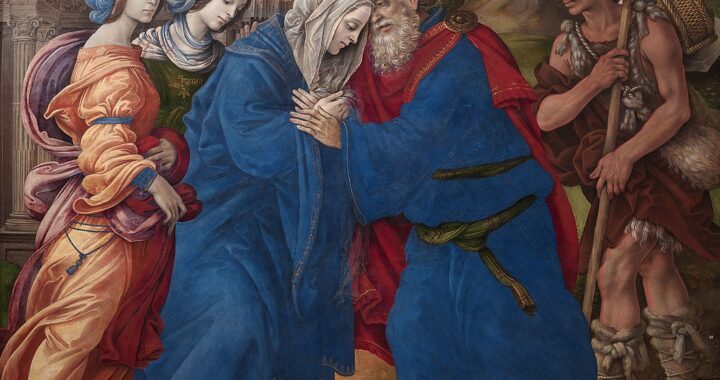
Wikimedia Commons
It is fitting that we commemorate Saint Rita of Cascia on May 22. This is fitting not only because it’s the date of her death, but also because the date is situated deep in the heart of the season of Easter. Only in the light of Easter can we understand one of the many remarkable things about this remarkable saint.
Rita was born in Roccaporena, a suburb of Cascia in Italy, in the fourteenth century. Although she wanted to be a nun, her family married her off to a nobleman when she was twelve years old, a common practice at the time. Her husband soon proved himself to be bad-tempered, abusive, and unfaithful. But Rita, proving her sanctity and making her the patron of innumerable unhappy wives for centuries ever since, eventually brought her husband to repentance and conversion through her love of God and through eighteen years of Christ-like patience and kindness.
There are many great stories about how Rita handled her husband’s murder, her sons’ fatal illnesses, her initial rejection when she asked to enter a convent, and her mystical gifts after she became a nun. But it is often overlooked that her body has remained incorrupt since her death in 1457.
As Joan Carroll Cruz points out in her book, The Incorruptibles, people noticed a sweet perfume in the church when Rita’s body was exposed in the church in Cascia prior to her burial. Miracles through her intercession were also noted soon after her death, which is why her body was placed beneath an altar but was still clearly visible. More than a hundred years later, the pope ordered her body to be examined, and it was “found to be as perfect as it had been on the day of her death (Cruz, The Incorruptibles, TAN Books: 1977, p. 131).”
Talking about examining dead bodies just seems, well, wrong, but the point is that Saint Rita is not the only one. The bodies of many Christian saints have been been found to be incorrupt, to greater or lesser degrees, for millennia. The most famous examples include Saints Cecilia of Rome, Louis Bertrand, Francis Xavier, Bernadette Soubirous, Andrew Bobola, Catherine of Siena, Sharbel Makhluf, John of the Cross, and Josaphat of Polotsk. These and other amazing phenomena experienced by the saints are admirably catalogued in Deacon Albert E. Graham’s Compendium of the Miraculous (also by TAN Books).
All people know what happens to living things—plants, animals, and humans—when they die. Their bodies begin to decompose. Every human culture has some sort of funerary rites based on their theological beliefs and other factors. Even though civilizations may differ in how they dispose of their deceased loved ones, they all do something.
In the natural course of things, human bodies decay. Western culture turns to burial out of respect for the dead, though modern health and safety issues are also involved. Even the most famous ancient culture’s funeral rites—Egyptian mummification—shows the same recognition that living matter will decompose completely if you don’t do something about it.
But over the centuries, Catholics have found that the bodies of some holy men and women do not follow that natural course. (We must set to one side the issue of incorruptibility among Orthodox saints. Although incorruptibility has sometimes been used as a criteria for acclaiming a saint for the Orthodox, their process of recognizing saints is very different and not formalized in the same way as in the Catholic Church.) The most important question here is: Why does this happen?
Why is it that, outside the Christian faith, the “incorruptibles” do not exist? That is, this phenomena is not known or expected in other religions or in certain geographical regions or in other cultures. It seems to be a uniquely Christian phenomena. But it has been found from the earliest centuries (Saint Cecilia of Rome, d. 177) to the present (Saint Sharbel Makhluf, who died in1898, but his body remained incorrupt up to 1950).
Notably, the Catholic Church does not believe that incorruptibility is a measure of holiness. The body of Saint Therese of Lisieux, for example, one of the holiest saints in the history of the Church, was not found to be incorrupt. So one cannot say that an incorrupt body is directly related to the living person’s holiness and that those whose bodies are not incorrupt are somehow less holy in God’s sight.
But the existence of incorrupt saints at all can only be explained in one way: God’s miraculous intervention. For some reason, God permits the bodies of some of His beloved sons and daughters to remain intact after their deaths.
Perhaps the most obvious reason for this intervention is the liturgical season that is still celebrated on Saint Rita’s feast day: Easter. Our Lord and Savior Jesus Christ rose bodily from the dead on Easter Sunday. His Risen Body is now in Heaven, and He waits to see us when we, God willing, will join Him there. The incorruptibles, therefore, remind us of His Resurrection from the dead, as well as “the resurrection of the body” described in our Creed and which we can all look forward to when He comes again.
And perhaps that is the other reason that God permits this miraculous phenomena in the first place. Saints Rita, Cecilia, Bernadette, and all the others whose bodies have not decayed after death are lying in churches right now. They are waiting for the Second Coming, like a mighty army waiting to welcome their returning king. Are we ready and waiting for that day when it comes too? If not, shouldn’t we be?
